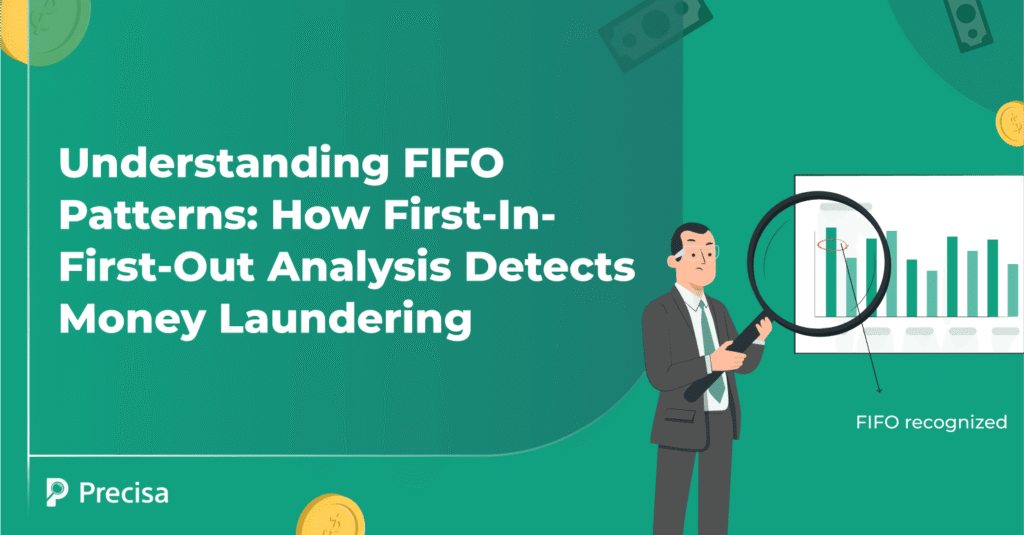Understanding FIFO Patterns: How First-In-First-Out Analysis Detects Money Laundering

You have a competent forensic team that excels in financial investigations. However, when money laundering transactions involve multiple bank accounts and thousands of transactions, does FIFO analysis still take weeks? These delays could leave your institution vulnerable and also pose a threat to a country’s financial system, its integrity, and sovereignty.
So what is the solution? Emerging and fast-evolving technology can help you deal with this challenge of sifting through voluminous transactions, spread across multiple jurisdictions and bank accounts and prevent money laundering effectively.
You can employ automated tools to aid your forensic team and focus on diverse aspects to spot money laundering. First-In-First-Out (FIFO) is a transactional pattern analysis that helps identify suspicious activity. It raises red flags in forensic audits and aids fraud prevention and detection.
Let us explore how identifying FIFO patterns can help all financial institutions in their anti-money laundering crusade.
Money Laundering: A Threat To Financial and National Stability
Money laundering refers to activities and practices that individuals or groups may follow to conceal the origins of funds obtained through illegal means and try to make these funds appear legitimate.
Early fraud detection is crucial in mitigating the potential damage that may result from these activities. Forensic audits play a crucial role in this by focusing on intent, manipulation, and hidden risks when analysing transactions. Periodic forensic analysis can also help identify potential threats and prevent them. Solutions like the one from Precisa go beyond traditional checks, relying on technology, analytics, and behavioural profiling to trace financial irregularities to their roots.
A report by the FICCI revealed that trade-based money laundering in India soared to a whopping $674.9 billion for the 10 years from 2009 to 2018, an indicator of the magnitude of illicit trade that has emerged as a major threat to the country’s economy and security in the following ways:
1. Leads to Economic Instability
Tax evasion, financial corruption, illegal flow of funds, and the existence of a parallel economy negatively impact the country’s GDP and financial stability.
2. Source of Terror Financing
Money laundering is a major source of terror funding, threatening the nation’s national security and overall stability.
Challenges for Forensic Auditors
Financial institutions, such as banks, NBFCs, and DSAs, play a crucial role in the nation’s economic stability and growth. Money laundering activities also impact them directly in the following ways:
1. Attract Fines
All financial institutions (FIs) must adhere to the RBI-mandated guidelines, such as the KYC (Know Your Customer) guidelines. KYC refers to verifying customer identity. FIs must monitor all accounts to prevent fraudulent activities. Failure to comply with these rules can result in substantial fines or even the loss of their license.
2. Threatens Operational Stability
Any illicit routing of funds or fraudulent activities threatens the operational stability of the FI and leaves it vulnerable to fraud, defaults, and other operational challenges.
3. Erosion of Trust
Financial institutions facilitate savings, investments, and business transactions, and thrive on community trust. They are a potential target for money laundering activities; without adequate safety measures, they could inadvertently become part of criminal financial activity, leading to a loss of trust and reputation for the FI.
FIFO Patterns: An Indicator Of Money Laundering

FIFO tracking is a crucial tool for forensic auditors. These auditors are professionals who examine financial records for evidence of illegal activity. FIFO helps trace the origin and movement of suspicious funds. The First-In-First-Out method looks at bank statements. It studies the sequence in which money is deposited and withdrawn from an account. This analysis helps investigators determine if money came from legal or illegal sources.
Usually, fraudsters transfer money by making transactions across multiple accounts, returning to the original account in the end, or they route funds between multiple bank accounts in different cities or countries.
Typically, accounts that route money for laundering exhibit the following:
- The transactions follow a pattern that significantly deviates from the customer’s typical account activity; digital transaction analysis can spot anomalies and flag any unusual activity in accounts.
- These accounts exhibit a rapid turnover of funds to make the audit trail difficult to follow.
- An unusually large chunk of money is deposited; funds are withdrawn in the same order they were deposited. Automated transaction parsing performed by the bank statement analyser can pick these anomalies.
- Funds remain in the account for a very short period; it may be days or even hours. The entire amount is either withdrawn on the same day or the next day.
- The withdrawal can be in small multiple chunks or a single large debit.
- A minimal or negligible balance is left in the account; credit is matched by an almost equal and immediate debit.
- Precisa’s automated FIFO tracking helps identify the same pattern replicated across multiple linked accounts or entities. The funds are often directed to or from countries or regions known for weak anti-money laundering (AML) regulations or tax havens, to disguise the origin of the funds.
- FIFO activity in such accounts has no apparent business purpose. Funds are routed through multiple accounts or jurisdictions with no clear economic justification.
Leverage Technology to Monitor Accounts and Transactions
Emerging tech-based solutions can help all stakeholders reduce instances of financial fraud and also ensure that deserving customers are not flagged erroneously.
Explore how technology can support FIs and government agencies in their anti-money laundering efforts:
- Precisa’s automated advanced analytics speeds up Investigations, introduces reliable accuracy and reduces false positives. Real-time tracking of high-risk transactions can help identify illicit activity quickly, mitigating any potential damage
- Data analytics and machine learning tools can help identify rapid deposits and withdrawals, identify accounts with high transaction velocity, and minimal balance retention.
- AI-powered analytics offered by Precisa aid FIFO tracking for source-to-destination flow.
- Digital tools can perform multi-account cross-referencing, track inter-bank transfers across institutions, and provide First In, First Out (FIFO) tracking for precise money flow mapping from source to destination.
- Advanced Transaction Intelligence feature offered in the AML analysis solution performs UPI transaction analysis, featuring Reference Number (RRN) detection and advanced money trail visualisation. This empowers investigators to unravel intricate financial networks.
- Comprehensive money trail visualisation further enables the identification of suspicious transaction patterns, hidden beneficiaries, and circular flows, providing a clear and actionable overview of complex financial relationships.
- Smart Money Trail Detection feature helps track inter-bank transfers and circular transactions between seemingly unrelated accounts without any manual intervention.
- Transaction analysis helps pick out unusual patterns, such as frequent deposits from unrelated third parties followed by immediate withdrawals or transfers which is difficult to do when relying on manual scrutiny.
Key Takeaways
As money laundering activities become more sophisticated and complicated, forensic investigators need to use tools that aid their skills, to help them deal with the high volume of transactions in real time. Solutions like the Anti-Money Laundering (AML) Analysis from Precisa that focus on FIFO tracking can aid forensic auditors in meeting this challenge head-on. Their solution, unlike other options, is fully automated and does not rely on manual analysis, offering speed and accuracy, necessary to deal with complex cases and withstand legal scrutiny.
Anti-money laundering analysis software simplifies and speeds up the process through automation and provides actionable insights for informed decision-making.
Precisa’s AML Analysis empowers law enforcement agencies and financial institutions with cutting-edge tools to investigate cybercrime and money trails. The Analyser performs the following functions:
- Automatically verifies document authenticity.
- It extracts bank details and transactions from bank statements.
- Detects counterparties, analyses the data, and detects fraudulent and money laundering activities.
- It analyses data from multiple bank accounts in a single report.
- Offers visual money trail mapping to identify suspicious financial activity.
- Calculates AML and credit risk scores.
Looking for a solution that can help you detect and prevent any financial irregularities? Get in touch with us now for free forensic investigation demo.



